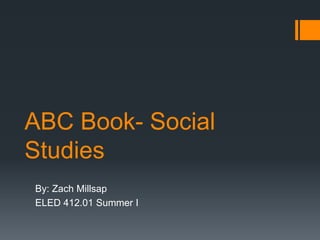
Abc book Social Studies
- 1. ABC Book- Social Studies By: Zach Millsap ELED 412.01 Summer I
- 2. A is for Articles of Confederation Weak central government for the United States during the Revolutionary War.
- 3. B is for Benjamin Franklin American statesman, diplomat, author, scientist, and inventor. He is best known as one of the Founding Fathers who drafted the Declaration of Independence and the Constitution of the United States.
- 4. C is for Civil War A war fought from 1861-1865 between northern and southern states over states rights and slavery. The northern states were known as the Union while the southern states were known as the Confederates.
- 5. D is for Democracy Citizens elect representatives to make and carry out laws. A government by the people. The current government of the United States of America.
- 6. E is for Export Goods being shipped or taken out of the country by another means of transportation.
- 7. F is for Federalists Persons in favor of ratification of the Constitution. Their adopted name implied a commitment to a loose, decentralized system of government.
- 8. G is for Great Depression The Great Depression began in 1929 and lasted until about 1939. An economic slump in North America, Europe, and other industrialized areas of the world that. It was the longest and most severe depression ever experienced by the industrialized Western world.
- 9. H is for Homestead A plot of land where pioneers could build a home farm or ranch.
- 10. I is for Industrial Revolution The dramatic change in economies brought about by the use of machines to do work formally done by hand.
- 11. J is for Jamestown, Virginia The first successful colony founded and established on the mainland in 1607.
- 12. K is for King George III The ruler of Great Britain from 1760-1820. During this time he was involved in many different string of wars and military battles.
- 13. L is for Louisiana Purchase In 1803, Thomas Jefferson and the purchased the territory from France, doubling the size of the United States and starting Manifest Destiny.
- 14. M is for Manifest Destiny The belief that the United States had the God given right to expand from Coast to Coast. This belief is how we became the United States that we are today.
- 15. N is for Neutrality not taking part in or giving assistance in a dispute or war between other countries.
- 16. O is for Ordinance A rule or law mandated and enforced by a country, state, or even city.
- 17. P is for Puritan a member of a group from England that settled the Massachusetts Bay Colony. They sought to reform practices of the Church of England.
- 18. Q is for Quakers people who believed all people should live in peace and harmony.
- 19. R is for Republic A country or state governed by elected representatives.
- 20. S is for Secession the process of formally withdrawing from a political organization because of a disagreement. The Confederate states wanted to secede from the United States over the issues of slavery and regional control.
- 21. T is for Tyranny The unjust use of governmental power. A single person known to be in charge known as a tyrant.
- 22. U is for Underground Railroad A series of escape routes for runaway slaves. Harriet Tubman is famous and known for her brave and courageous works.
- 23. V is for Virginia Plan A plan submitted by James Madison which called for 3 branches of government and a legislative branch using population as the bases of representation.
- 24. W is for World Wars Conflicts between multiple countries or nations that lead to war in many different areas. World War I was from 1914 through 1918 and included Allies and Central Powers. World War II was from 1939 through 1945 and included Allies and Axis.
- 25. X is for XYZ affair A political and diplomatic in 1798 between the United States and the Republican France that led to the Quasi-War.
- 26. Y is for Yorktown The final battle of the Revolutionary war took place here. The United States defeat Britain.
- 27. Z is for Zylcon B The name of the poisonous gas used by Hitler in the Nazi gas chambers.